Best of India Tours
- Golden Triangle Tour- Best of India & Nepal
- Classical Rajasthan
India Cultural Tours
- Images of North India- Karnataka Heritage
- Rajasthan & Goa Tour
Discover India Tours
- Grand India Tour- North to South India
- Central to South India
Rajasthan Tours
- Classical Rajasthan Tour- Golden Triangle Tour
- Grand Mughal Tour
India Luxury Trains
- Palace on Wheels- The Golden Chariot
- India Deccan Odyssey
- The Indian Maharaja
- Royal Rajasthan on Wheels
Nepal Tours
- Glimpses of Nepal- Buddhist Pilgrimage
- Nepal River Rafting
- Destinations of Nepal
- Nepal General Info
India Wildlife Tours
- North India Wild Life- South India Wildlife
Tibet Tours
- Tibet Monastery Tours- Explore Tibet
- Destinations of Tibet
Spa & Yoga Tours
- Ananda in Himalayas- Yoga & Meditation
Adventure Tours
- Manali Safari Tour- Himalayan Trekking
- Horse Safari
Goa
Bombay - Goa Tour Rajasthan & Goa Tour
Send us an email:info@india-travel-services.com for hotels, beach resorts, budget hotels in Goa.

Like a child joyfully rotating a kaleidoscope and chuckling at the changing patterns, one just gets hooked on to Goa. Beauty can be quite inebriating and here you have so much of it—in the golden sands, the blue waters, the sylvan forests and the lakes. Palm-swathed hills, islands, beaches and riverine waters rush to the freedom of the waves, unfold, meet the eye and merge with yet another visual wonder which the land generously and continuously keeps unfolding. Add to this the spicy nip of the sea, the tang of fish-curry rice, the moistened sips of cocum, the pleasure of discovering a crab under a stone, and the thrill of walking on a beach full of crisp seashells. The mind stops thinking and the heart begins speaking!
Come monsoon and this hundred-kilometre coastline turns into a fantasyland. Wild wind that rustles the hair, a sprinkle of water drops all around. On one side stand Goa Tourism, Beach Holidays, Church in Goa, Goa Tourisum.the palm trees, lush green and swaying in the wind, and on the other the vast Indian Ocean greets you. The dense cover of the clouds makes the ocean look darker than usual until some clouds part sending down brilliant beams of sunrays which hits the ocean turning it into a radiant jewel of a thousand diamonds. This and much more is the charm of Goa.
Situated on the western coastline of India, Goa is split into two districts, North Goa with the capital city of Panaji and South Goa with places such as Vasco da Gama and Margao. The history of the place goes far back in time when it was a part of the Mauryan Empire around 3rd century BC. Later the place came under the influence of Satavahanas, Chalukyans, Vijaynagar, Adil Shahi Dynasty of Bijapur, and finally the Portuguese who under Alfonso de Albuquerque invaded Goa in 1510. They ruled the region till 1961, when the Indian forces liberated it and Goa became a part of the Republic of India.
Sightseeing
In the local dialect, Goa is often referred to as ”Goa Dourada,” (meaning ”Golden Goa”) because of its beaches, forts, churches, waterfalls, seminaries, and caves. The beaches such as Dona Paula, Calangute, Anjuna, Colva, Miramar, and Vagator can be compared with the best beaches around the world. Churches and forts in Old Goa take the visitor to an era far back in time. Goa is rich not only in culture or entertainment, but it also has a rich floral and faunal heritage making it a complete destination.
Excursions
Medieval and colonial architecture, wildlife, lakes, and rivers; the state of Goa is full of all these and more. The wildlife sanctuaries of the state may not have as much abundance of denizens but the relative serenity and better tourist facilities made up for that. Sanctuaries like Molem Wildlife Sanctuary, Dandeli, and Bondla are the part of wild heritage that Goa has still survived despite ever increasing number of people encroaching up on the forestland. Temple of Tambdi Surla is one of the few religious structures in the state that survived Portuguese onslaught while Mayem Lake is the favourite escape of the locals
Excursions for Goa
Dona Paula
With its aura of romance and myth, the Dona Paula Beach is thronged by tourists not only in search of their deceased beloved, but also to indulge in water sports on the clear waters. The beach is named after Dona Paula de Menezes, the daughter of a viceroy who threw herself off the cliff when refused permission to marry a local fisherman named Gaspar Dias. The Dona Paula Sports Club provides facilities for cycling, motorboat rides, water-scooter, windsurfing, toboggan, ski-biscuit, toboggan, water-skiing, parasailing, skibob, sports fishing, snorkelling, harpoon fishing, yachting, and kayaking on the beach.

Old City & Churches
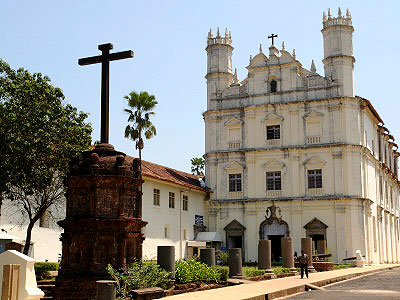
Old Goa is only nine kilometres east of Panaji. Founded in 1510 by Alfonso de Albuquerque as the old capital, the place is replete with churches like the Se Cathedral, the Convent and Church of St. Francis of Assisi (largest Christian church in Asia), Professed House and Basilica of Bom Jesus, the Church and Convent of St. Monica, the Church of St. Cajetan and the ruins of the Church of St. Augustine.
Panaji
Too small and mellow for a state capital, Panaji is situated on the south bank of the Mandovi River. The place became capital of Goa in 1843, replacing Old Goa. Unlike most parts of India, people here are friendly, perhaps an effect of long relations with people from other parts of the world. The city is charming and the colonial effect is evident in the city landscape. In Panaji, one must visit the church dedicated to our Lady of Immaculate Conception, and the Chapel of St. Sebastian. The Goa State Museum, the Secretariat, the statue of Abbe Faria in the capital is a must see for lovers of art. Visit a Goan market and you will discover the essence of the land. There is fish in plenty, woven baskets and earthen pots, pickles and preserves, tender coconuts and bananas and, if you’re lucky, even blue china and bronzed candelabras
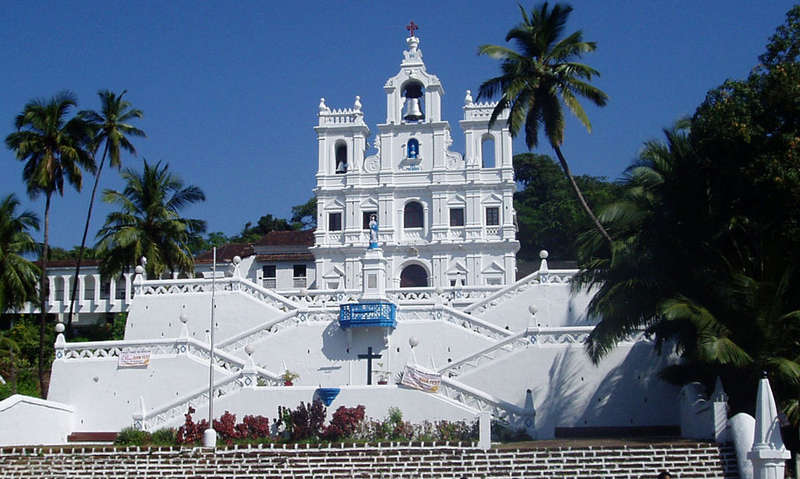
Mapusa Bazaar
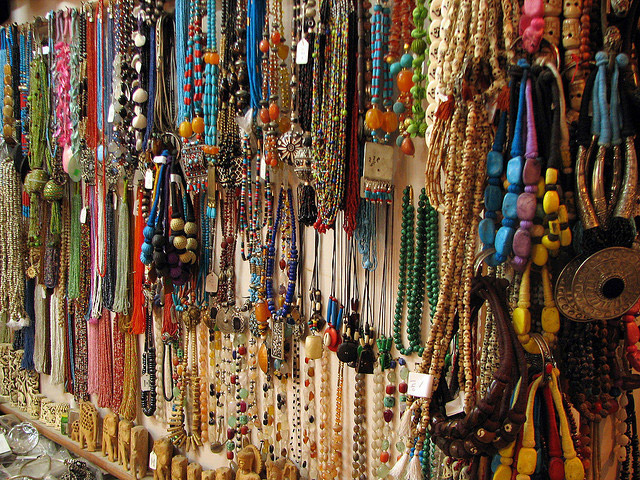
Mapusa, which is the main market town in north Goa, may well be the primal site of the oldest weekly fair on the Konkan coast. It witnesses the weekly and happy conclave of buyers and sellers from all over Goa on Fridays. The Mapusa weekly fair is the logical sequence to the ancient festivals in honour of Kanakeshwar Baba, venerated at the Bodgeshwar temple.
Ponda
Antruz, the inspired name of the Ponda subdivision, was the redoubt where the Hindus, displaced by the Portuguese from the coast, barricaded themselves between rivers and hills to hold their sway. Here they preserved their culture and further enriched it. From this area came Kesarbai Kerkar, one of India’s greatest singers; as also Dinanath Mangeshkar, the father of Lata Mangeshkar and Asha Bhonsle; and such other singers as Jitendra Abisheki, Mogubai Kurdikar—a great singer herself and the mother of the incomparable Kishori Amonkar. The area has several Hindu temples such as Sri Ganapati Temple and Mahalaxmi Temple.
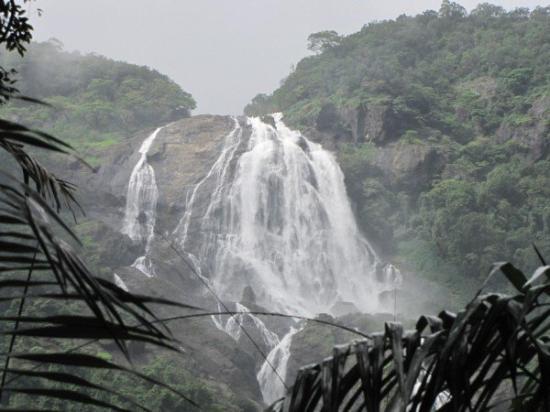
Shri Mangesh Temple
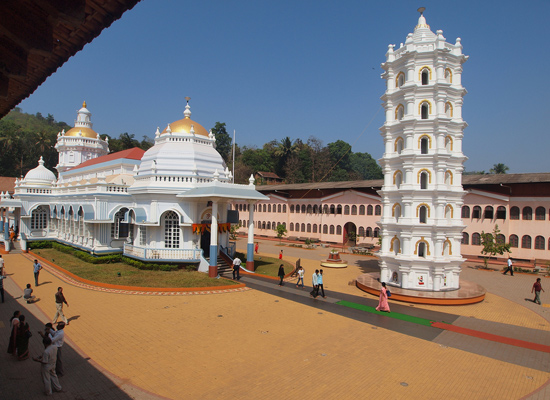
Most of the temples in Goa have deities brought from Mithila region in Bihar to which the Saraswat Brahmins of this region are believed to belong. The ancient Mangesh Temple is situated on the banks of the river Gomati or Zuari as it is called today. Lord Mangesh is worshipped here in the shape of a Shiva linga. The linga is said to have been consecrated on the mountain of Mangireesh (Mongir) on the banks of river Bhagirathi by Lord Brahma himself, from where the Saraswat Brahmins brought it to Trihotrapuri in Bihar. They carried the linga on to Gomantaka and settled at Mathagrama, the present-day Madgoa, and established their most sacred temple.
Shri Shanta Durga Temple
The Goddess of peace, Shanta Durga or Shanteri, resides in her holy abode at Kapilpura or Kavele in Antruz. This deity is believed to have been carried by Loma Sharma when the Saraswats came to Goa from Tiruhut in Bihar.
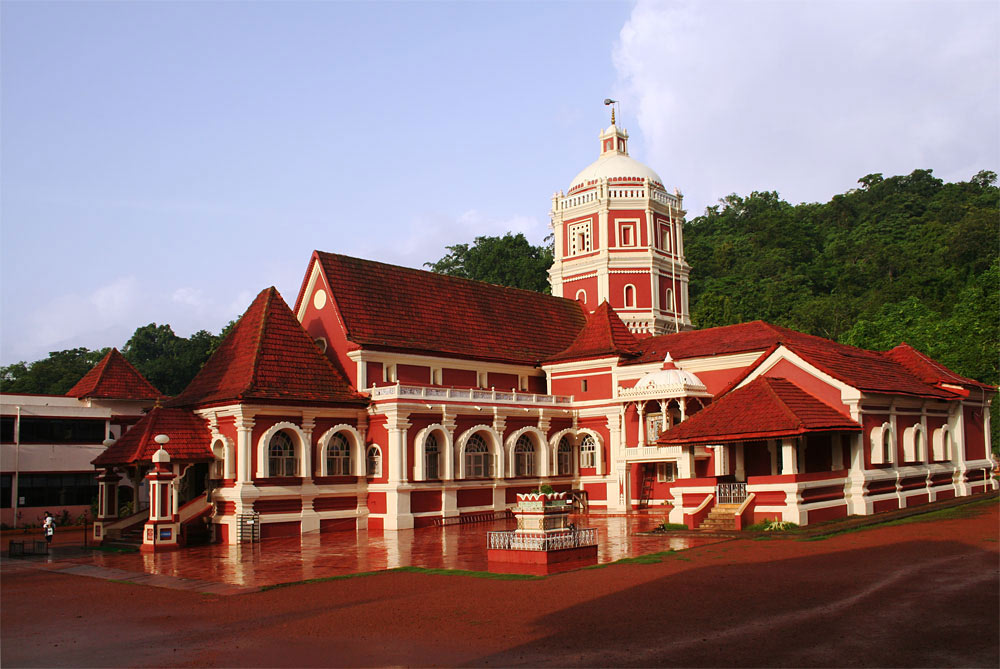
Shri Ramnath Temple
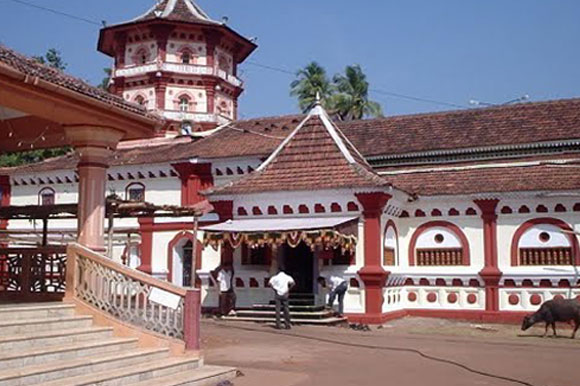
The temple of Shri Ramnath is situated at Ponda around 33 km from Panaji. Apart from the main temple, there are four other temples, namely of Shri Betal, Shri Shantadurga (Shanteri), Shri Laxminarayan, and Shri Sidhanath. All these temples together constitute Shri Ramnath Panchayatan.
Calangute
Old Goa is only nine kilometres east of Panaji. Founded in 1510 by Alfonso de Albuquerque as the old capital, the place is replete with churches like the Se Cathedral, the Convent and Church of St. Francis of Assisi (largest Christian church in Asia), Professed House and Basilica of Bom Jesus, the Church and Convent of St. Monica, the Church of St. Cajetan and the ruins of the Church of St. Augustine.
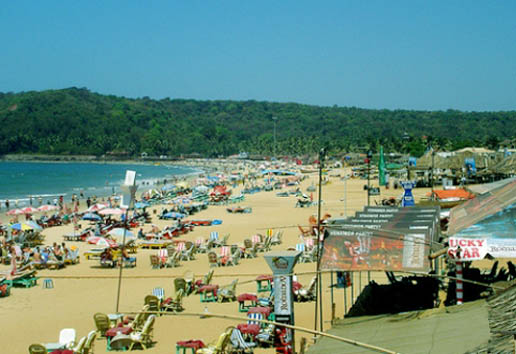
Anjuna
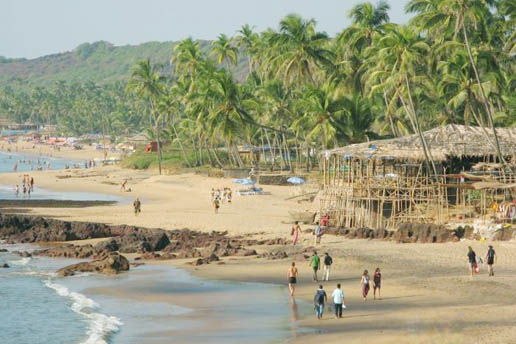
Also known as the freak capital of the world, Anjuna beach is just the right place for lazing holidaymakers. The place comes live with its ever-famous full-moon parties and the Wednesday flea market to take one on to a trance trip. The beach is most popular among the local populace who love its 20-km-long virgin white sands, fringed and sun drenched.
Miramar
Miramar or Gaspar Dias is one of the beach that are much nearer to Panaji and ignored by many tourists. This should come as a blessing as the crowd here is lesser than other popular beaches in Goa. But this small beach can be used for little beyond sunbathing, since the undercurrents and flow are dangerous.
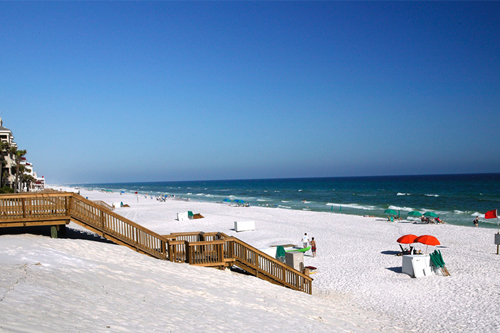
Vagator

Overlooked by the 500-year-old Portuguese fort, the Vagator beach with its soft white sands, the black lava rocks, the coconut palms, and the lush green landscape leaves each visitor awestruck. The beach is located north to the Anjuna and despite being disturbed by the hustle and bustle of tourists, life goes on peacefully here in the background.
Bondla Forest Sanctuary
Also known as Bhagwan Mahavir Wildlife Sanctuary, this place is situated along the north-east border of Goa at Molem around 60 km from Panaji. The sanctuary covers an area of 240 sq. km and is the biggest of the three wildlife sanctuaries in Goa. The sanctuary is a birdwatchers’ paradise. Besides, there are many floral and faunal varieties that would attract you towards it.
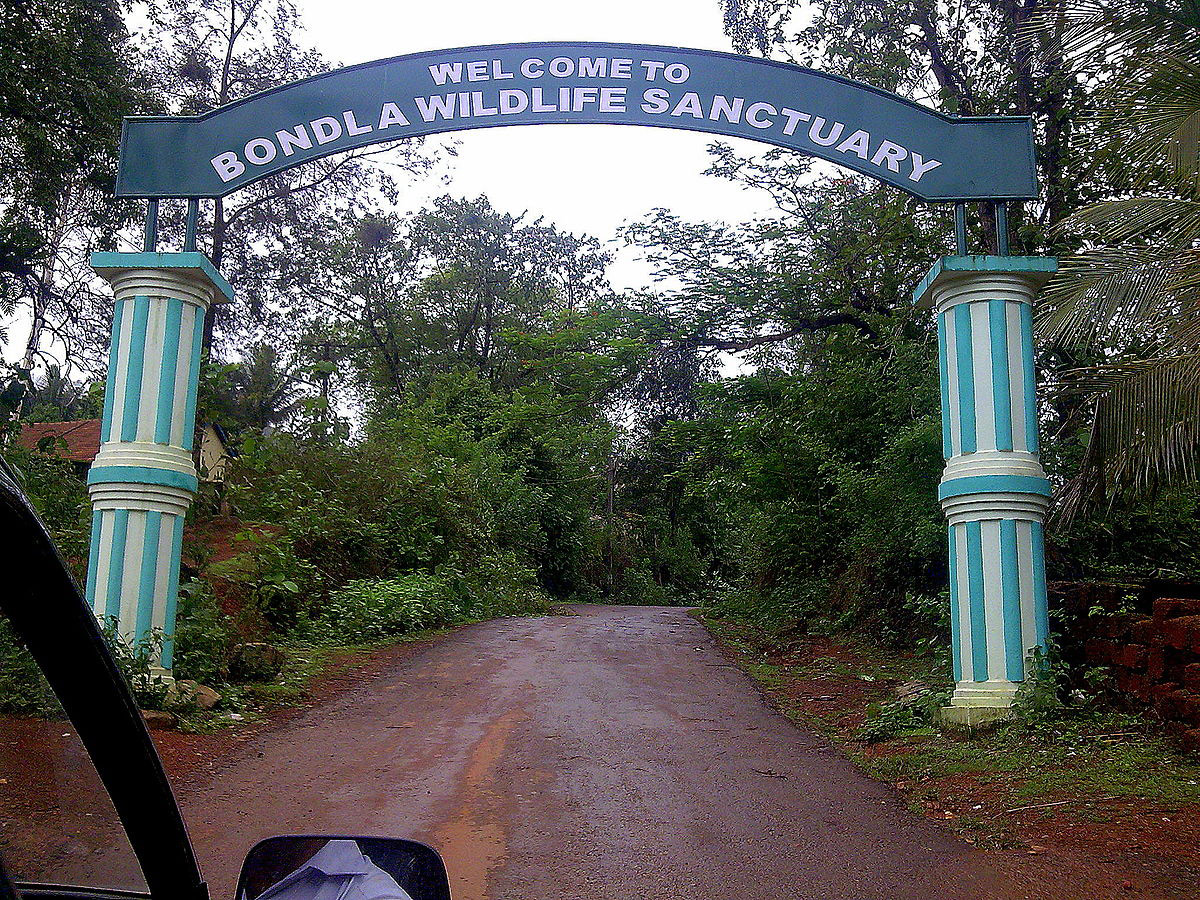
Dandeli
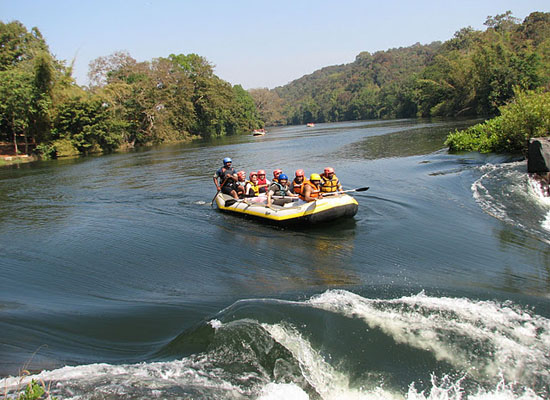
Situated in the state of Karnataka just outside the Goa border, the Dandeli Sanctuary abounds in flora and fauna. It has an undulating topography with steep slopes, picturesque river valleys, and rich hilly forest terrain. The main wildlife species include elephant, tiger, leopard, gaur, flying squirrel, mouse deer, etc., and a variety of birds.
Mayem Lake
Mayem Lake is a calm spread of water with cottages hidden in the wooded slopes. If you want to enjoy the real thrill of Goa along with the local populace, you must visit this beautiful lake situated around 65 km from Vasco-da-Gama and 64 km from Dabolim airport.
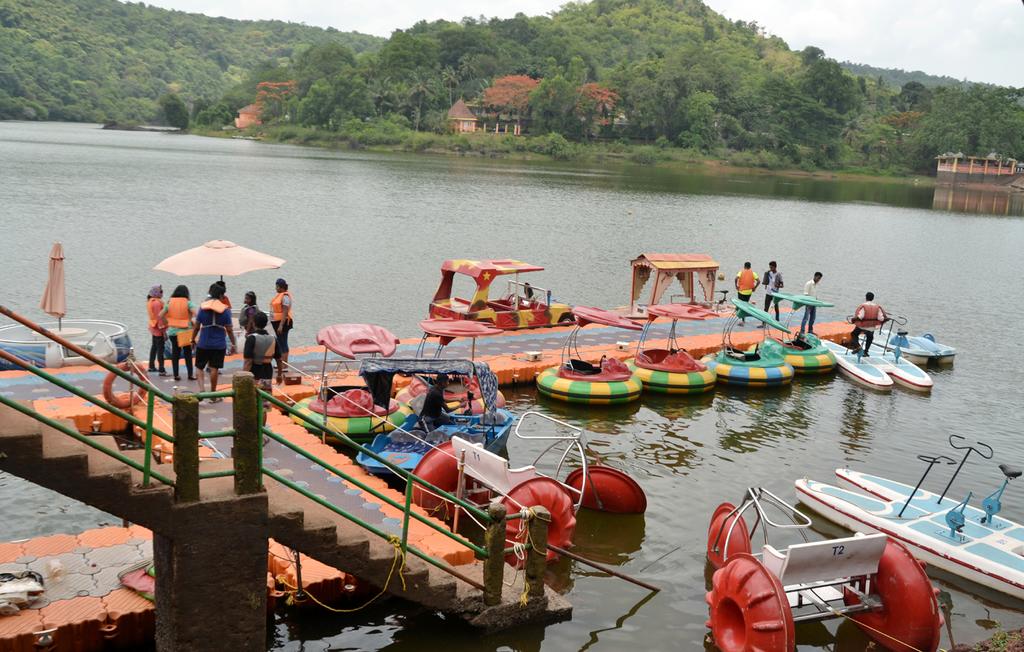
Molem Wildlife Sanctuary
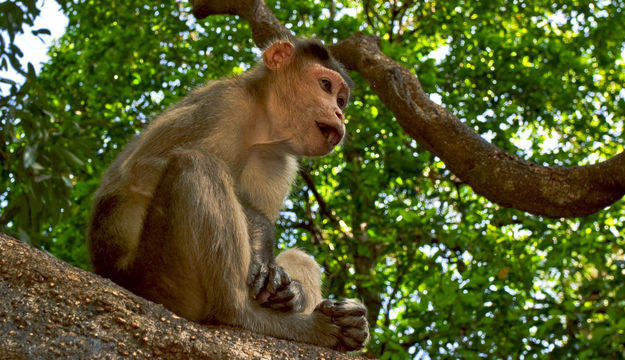
Also known as Bhagwan Mahavir Wildlife Sanctuary, this place is situated along the north-east border of Goa at Molem around 60 km from Panaji. The sanctuary covers an area of 240 sq. km and is the biggest of the three wildlife sanctuaries in Goa. The sanctuary is a birdwatchers\’ paradise. Besides, there are many floral and faunal varieties that would attract you towards it.
Temple of Tambdi Surla
When most of the temples in Goa were being destroyed by the Portuguese, this temple escaped because of its remote location. The temple is located at Sanguem Taluka around 66 km away from Panaji.

Fact File
 Area: 3,702 sq. km
Area: 3,702 sq. km
 Population:1,169,793
Population:1,169,793
 Altitude: Sea level
Altitude: Sea level
 Best Time to Visit: October to February
Best Time to Visit: October to February
 Languages:Konkani, Marathi, Hindi, English
Languages:Konkani, Marathi, Hindi, English
 STD Code:0832
STD Code:0832




